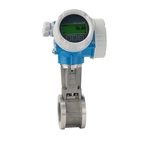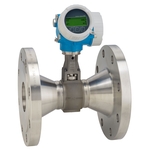
Vortex flowmeters
Vortex flow measurement: Robust and universally applicable for liquids, gases and steam
Vortex flowmeters are used in numerous branches of industry to measure the volume flow of liquids, gases and steam. Applications in the chemicals and petrochemicals industries, for example, in power generation and heat-supply systems involve widely differing fluids: saturated steam, superheated steam, compressed air, nitrogen, liquefied gases, flue gases, carbon dioxide, fully demineralized water, solvents, heat-transfer oils, boiler feedwater, condensate, etc.
You've viewed 8 of 32 products
Unique Prowirl 200
Vortex flowmeters are also in widespread use for measuring mass flow. Therefore, modern vortex meters such as the multivariable Prowirl 200 are built for more than merely measuring volume flow, and come complete with temperature sensor and flow computer.
Prowirl 200 is the world’s first vortex meter with the option of monitoring the steam quality and immediately generating an alarm message in case of wet steam. Prowirl 200 can also be used for flow monitoring systems up to SIL 2 and SIL 3 and is independently evaluated and certified by TÜV Rheinland in accordance with IEC 61508.
The Vortex Flow Measuring Principle
Steam Quality Measurement with Prowirl F 200 - For Maximum Operational Safety, Energy and Cost Efficiency
This film shows that Prowirl 200 is the most robust vortex flowmeter worldwide even under extreme process conditions.
Detection of wet steam Measurement of the dryness fraction of steam.
Vortex flow measuring principle
This measuring principle is based on the fact that turbulence forms downstream of obstacles in the flow, such as a bridge pier.
Inside each vortex flowmeter, a bluff body is therefore located in the middle of the pipe. As soon as the flow velocity reaches a certain value, vortices form behind this bluff body, are detached from the flow and transported downstream. The frequency of vortex shedding is directly proportional to mean flow velocity and thus to volume flow.
The detached vortices on both sides of the bluff body generate alternately a local positive or negative pressure that is detected by the capacitive sensor and fed to the electronics as a primary digital, linear signal.
Benefits
- Universally suitable for measuring liquids, gases and steam
- Largely unaffected by changes in pressure, density, temperature and viscosity
- High long-term stability: no zero-point drift and lifetime K-factor
- Large turndown of typically 10:1 to 30:1 for gas/steam, or up to 40:1 for liquids
- Wide temperature range: –200 to +400 °C (+450 °C on demand)





